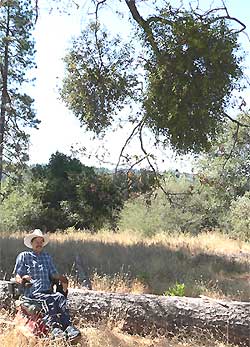Excerpts from Jim Conrad's
Naturalist Newsletter
from the September 25, 2005 Newsletter issued from the Sierra Nevada foothills
somewhat east of Placerville, California, USA
OAK MISTLETOE
The other day Fred and I went out to bring in some firewood and we passed by a big oak with some low- hanging mistletoe.  If only because it formed such a large, drooping clump, it was clear that this was a species different from what I knew from the East. This was Oak Mistletoe, PHORADENDRON VILLOSUM. You can see a picture with Fred beside the plant for scale at the right:
If only because it formed such a large, drooping clump, it was clear that this was a species different from what I knew from the East. This was Oak Mistletoe, PHORADENDRON VILLOSUM. You can see a picture with Fred beside the plant for scale at the right:
By the way, the above picture also shows how parched the landscape here looks now, wildflowers and grass dun colored and trees having a silvery cast to them very unlike the deep greens of the rainier East. You don't see mountains in that view because we're looking westward, across the canyon toward the Central Valley below.
Oak Mistletoes are flowering now. I snapped springs off the two plants above Fred in the picture and on both found stubby little green spikes about half an inch long, each spike equipped with 15-25 tiny, very simple female flowers. Each flower consisted of nothing but an egglike, green pistil subtended by three green, triangular, hairy sepals, and the flowers were sunken into the spike's axis. The other mistletoe plants were too high for me to see if any male plants were there, but I knew that if I'd found one each male flower would have borne three stamens. In the world of dicots, it's a little unusual to find flowers with parts arranged in threes.
You can see the flowers on PlantSystematics.Org's Phoradendron villosum page. Also, distribution maps for North America's several Phoradendron species, including our P. villosum, can be seen at Bonap.Net's North American Plant Atlas, Phoradendron page.
Actually, though I value their information, that page almost rubs me the wrong way with the manner by which it claims that "The damage caused by mistletoes in most cases outweighs their economic values." This economic calculation doesn't take into account the mistletoe's value to the ecosystem, which in the long term also has economic value. Mistletoes produce fruits much relished by many kinds of birds. In the dry, airy space inside their host trees they produce relatively lush, shaded microhabitats for many kinds of arboreal invertebrates, which then serve as food sources for birds and other creatures. Also, mistletoes have value just being themselves, by adding diversity and a pleasing esthetic element to the landscape. From what I've seen it's very seldom that their parasitism really hurts a tree, though I'm sure that sometimes that happens.
At least at a site produced by Southern Illinois University some un-named person wrote this:
"As a plant biologist interested in parasitic plants, when I look at a tree heavily infested with Phoradendron, I say 'Wow, look at that wonderful population of Phoradendron!' When others look at it, they may say 'Oh, that poor tree!' It's a mindset thing. I know that there is not much one can do about a tree with all that mistletoe, so I try to appreciate the marvelous coevolutionary relationship that is taking place."
In California we have two other mistletoe genera, and in the present genus Phoradendron we have seven species. The various Phoradendron species are particular about whom they parasitize. For example, P. californicum restricts its hosts to members of the Bean Family, such as acacias and mesquite. P. juniperinum sticks to junipers. P. pauciflorum grows on White Fir. Our P. villosum is a little less persnickety, parisitizing many oak species as well as manzanita, sumac and a few other woody dicots.
 If only because it formed such a large, drooping clump, it was clear that this was a species different from what I knew from the East. This was Oak Mistletoe, PHORADENDRON VILLOSUM. You can see a picture with Fred beside the plant for scale at the right:
If only because it formed such a large, drooping clump, it was clear that this was a species different from what I knew from the East. This was Oak Mistletoe, PHORADENDRON VILLOSUM. You can see a picture with Fred beside the plant for scale at the right: